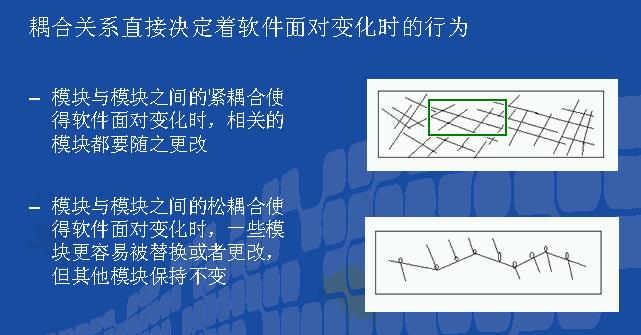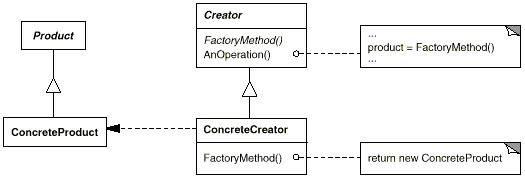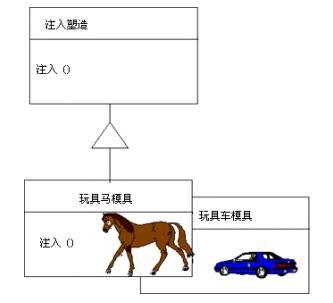工厂方法模式(Factory Method)
耦合关系:

动机(Motivation):
在软件系统中,由于需求的变化," 这个对象的具体实现"经常面临着剧烈的变化,但它却 有比较稳定的接口。
如何应对这种变化呢?提供一种封装机制来隔离出"这个易变对象"的变化,从而保持系统中"其它依赖的对象"不随需求的变化而变化。
意图(Intent):
定义一个用户创建对象的接口,让子类决定实例哪一个类。Factory Method使一个类的实例化延迟到子类。
----------《设计模式》GOF
结构图(Struct):

生活实例:

适用性:
1.当一个类不知道它所必须创建的对象类的时候。
2.当一个类希望由它子类来指定它所创建对象的时候。
3.当类将创建对象的职责委托给多个帮助子类中的某个,并且你希望将哪一个帮助子类是代理者这一信息局部化的时候。
实例代码:
CarFactory类:
Factory Method模式主要用于 隔离类对象的使用者和具体类型之间的耦合关系。面对一个经常变化的具体类型,紧耦合关系会导致软件的脆弱。
Factory Method模式通过面向对象的手法,将所要创建的具体对象工作延迟到子类,从而实现一种扩展(而非更改)的策略,较好地解决了这种紧耦合关系。
Factory Mehtod模式 解决"单个对象"的需求变化, AbstractFactory模式 解决"系列对象"的需求变化, Builder模式 解决"对象部分"的需求变化。

动机(Motivation):
在软件系统中,由于需求的变化," 这个对象的具体实现"经常面临着剧烈的变化,但它却 有比较稳定的接口。
如何应对这种变化呢?提供一种封装机制来隔离出"这个易变对象"的变化,从而保持系统中"其它依赖的对象"不随需求的变化而变化。
意图(Intent):
定义一个用户创建对象的接口,让子类决定实例哪一个类。Factory Method使一个类的实例化延迟到子类。
----------《设计模式》GOF
结构图(Struct):

生活实例:

适用性:
1.当一个类不知道它所必须创建的对象类的时候。
2.当一个类希望由它子类来指定它所创建对象的时候。
3.当类将创建对象的职责委托给多个帮助子类中的某个,并且你希望将哪一个帮助子类是代理者这一信息局部化的时候。
实例代码:
CarFactory类:
1
public
abstract
class
CarFactory
2 {
3 public abstract Car CarCreate();
4 }
Car类:
2 {
3 public abstract Car CarCreate();
4 }
1
public
abstract
class
Car
2 {
3 public abstract void StartUp();
4 public abstract void Run();
5 public abstract void Stop();
6
7 }
HongQiCarFactory类:
2 {
3 public abstract void StartUp();
4 public abstract void Run();
5 public abstract void Stop();
6
7 }
1
public
class
HongQiCarFactory:CarFactory
2 {
3 public override Car CarCreate()
4 {
5 return new HongQiCar();
6 }
7 }
BMWCarFactory类:
2 {
3 public override Car CarCreate()
4 {
5 return new HongQiCar();
6 }
7 }
1
public
class
BMWCarFactory:CarFactory
2 {
3 public override Car CarCreate()
4 {
5 return new BMWCar();
6 }
7 }
HongQiCar类:
2 {
3 public override Car CarCreate()
4 {
5 return new BMWCar();
6 }
7 }
1
public
class
HongQiCar:Car
2 {
3 public override void StartUp()
4 {
5 Console.WriteLine( " Test HongQiCar start-up speed! " );
6 }
7 public override void Run()
8 {
9 Console.WriteLine( " The HongQiCar run is very quickly! " );
10 }
11 public override void Stop()
12 {
13 Console.WriteLine( " The slow stop time is 3 second " );
14 }
15 }
BMWCar类:
2 {
3 public override void StartUp()
4 {
5 Console.WriteLine( " Test HongQiCar start-up speed! " );
6 }
7 public override void Run()
8 {
9 Console.WriteLine( " The HongQiCar run is very quickly! " );
10 }
11 public override void Stop()
12 {
13 Console.WriteLine( " The slow stop time is 3 second " );
14 }
15 }
1
public
class
BMWCar:Car
2 {
3 public override void StartUp()
4 {
5 Console.WriteLine( " The BMWCar start-up speed is very quickly " );
6 }
7 public override void Run()
8 {
9 Console.WriteLine( " The BMWCar run is quitely fast and safe!!! " );
10 }
11 public override void Stop()
12 {
13 Console.WriteLine( " The slow stop time is 2 second " );
14 }
15 }
app.config
2 {
3 public override void StartUp()
4 {
5 Console.WriteLine( " The BMWCar start-up speed is very quickly " );
6 }
7 public override void Run()
8 {
9 Console.WriteLine( " The BMWCar run is quitely fast and safe!!! " );
10 }
11 public override void Stop()
12 {
13 Console.WriteLine( " The slow stop time is 2 second " );
14 }
15 }
1
<?
xml version
=
"
1.0
"
encoding
=
"
utf-8
"
?>
2 < configuration >
3 < appSettings >
4 < add key = " No1 " value = " HongQiCarFactory " />
5 < add key = " No2 " value = " BMWCarFactory " />
6 </ appSettings >
7 </ configuration >
Program类:
2 < configuration >
3 < appSettings >
4 < add key = " No1 " value = " HongQiCarFactory " />
5 < add key = " No2 " value = " BMWCarFactory " />
6 </ appSettings >
7 </ configuration >
1
class
Program
2 {
3 static void Main( string [] args)
4 {
5 Console.WriteLine( " Please Enter Factory Method No: " );
6 Console.WriteLine( " ****************************** " );
7 Console.WriteLine( " no Factory Method " );
8 Console.WriteLine( " 1 HongQiCarFactory " );
9 Console.WriteLine( " 2 BMWCarFactory " );
10 Console.WriteLine( " ****************************** " );
11 int no = Int32.Parse(Console.ReadLine().ToString());
12 string factoryType = ConfigurationManager.AppSettings[ " No " + no];
13 // CarFactory factory = new HongQiCarFactory();
14 CarFactory factory = (CarFactory)Assembly.Load( " FactoryMehtod " ).CreateInstance( " FactoryMehtod. " + factoryType); ;
15 Car car = factory.CarCreate();
16 car.StartUp();
17 car.Run();
18 car.Stop();
19
20 }
21 }
Factory Method 模式的几个要点:
2 {
3 static void Main( string [] args)
4 {
5 Console.WriteLine( " Please Enter Factory Method No: " );
6 Console.WriteLine( " ****************************** " );
7 Console.WriteLine( " no Factory Method " );
8 Console.WriteLine( " 1 HongQiCarFactory " );
9 Console.WriteLine( " 2 BMWCarFactory " );
10 Console.WriteLine( " ****************************** " );
11 int no = Int32.Parse(Console.ReadLine().ToString());
12 string factoryType = ConfigurationManager.AppSettings[ " No " + no];
13 // CarFactory factory = new HongQiCarFactory();
14 CarFactory factory = (CarFactory)Assembly.Load( " FactoryMehtod " ).CreateInstance( " FactoryMehtod. " + factoryType); ;
15 Car car = factory.CarCreate();
16 car.StartUp();
17 car.Run();
18 car.Stop();
19
20 }
21 }
Factory Method模式主要用于 隔离类对象的使用者和具体类型之间的耦合关系。面对一个经常变化的具体类型,紧耦合关系会导致软件的脆弱。
Factory Method模式通过面向对象的手法,将所要创建的具体对象工作延迟到子类,从而实现一种扩展(而非更改)的策略,较好地解决了这种紧耦合关系。
Factory Mehtod模式 解决"单个对象"的需求变化, AbstractFactory模式 解决"系列对象"的需求变化, Builder模式 解决"对象部分"的需求变化。